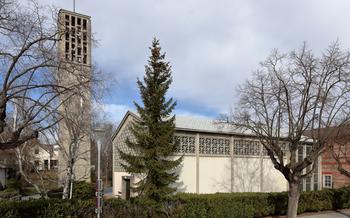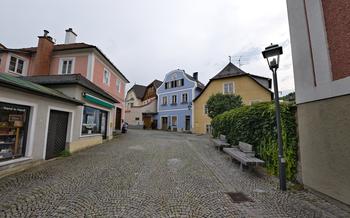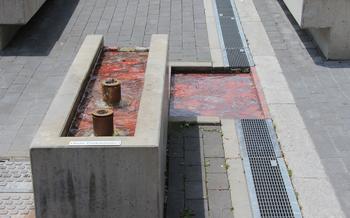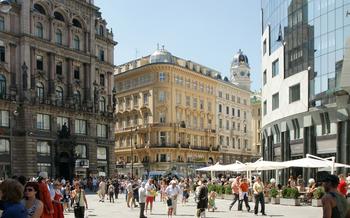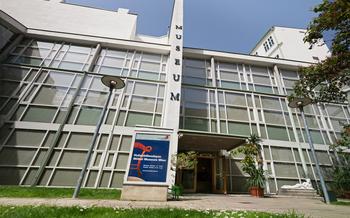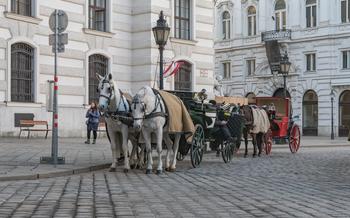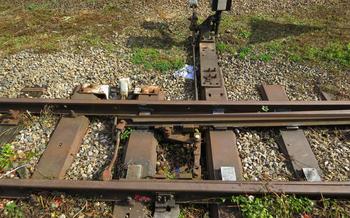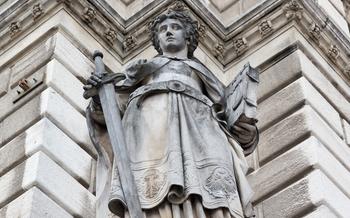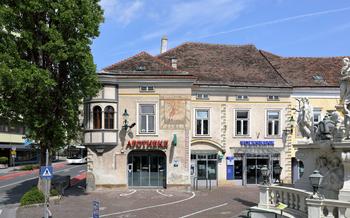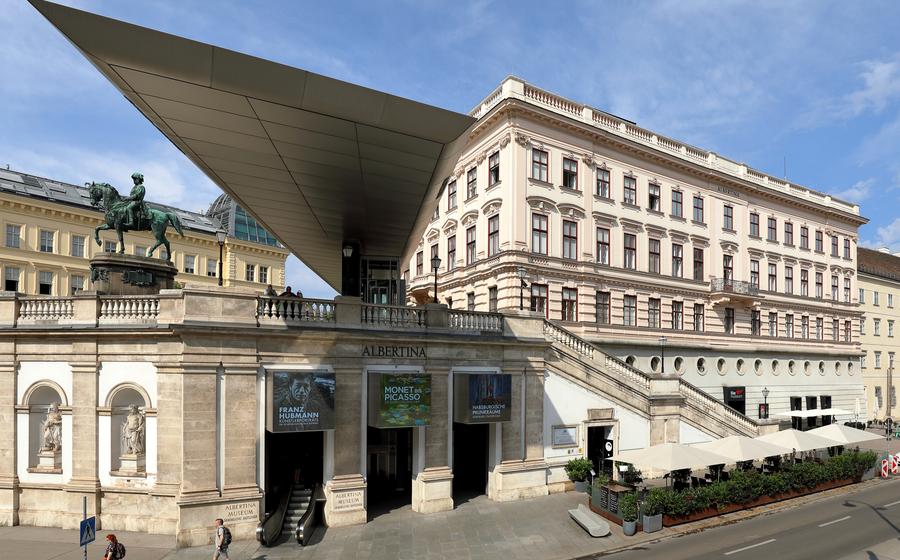
Albertina Museum & Art Gallery
- Must-See Masterpieces: Exploring the Albertina's Collection
- The Batliner Collection: A Glimpse into Modern and Contemporary Art
- Interactive Exhibitions for Art Enthusiasts: Engaging with the Collection
- The Albertina's Legacy: Preserving and Promoting Art and Culture
- Practical Tips for Planning Your Visit: Making the Most of Your Time
- Audio Guides and Guided Tours: Enhancing Your Museum Experience
- Unique Events and Programs: Beyond the Galleries
- Accessibility and Inclusivity: Ensuring a Welcoming Environment
- Location and Transportation: Getting to the Albertina Museum
- Nearby Attractions and Points of Interest: Exploring Vienna's Cultural District
- Historical Significance and Cultural Context: Understanding the Albertina's Role
- Insider Tip: Unveiling Hidden Gems
Must-See Masterpieces: Exploring the Albertina's Collection
In the heart of Vienna, the Albertina Museum & Art Gallery proudly presents a remarkable collection that spans centuries and art movements. Among the must-see masterpieces that grace its walls are:
-
Albrecht Dürer's "Hare" (1502): A symbol of precision and observation, Dürer's intricate rendering of a hare captures the essence of nature with astonishing detail.
-
Claude Monet's "Water Lilies" (1899): Immerse yourself in the tranquil beauty of Monet's water lilies, where vibrant colors and gentle brushstrokes create a serene and meditative atmosphere.
-
Vincent van Gogh's "Self-Portrait" (1889): Van Gogh's intense and expressive self-portrait reveals the artist's inner turmoil and emotional depth, captivating viewers with its raw energy.
-
Gustav Klimt's "Judith I" (1901): Klimt's iconic portrayal of the biblical heroine Judith, adorned with intricate gold leaf and shimmering jewels, embodies the artist's fascination with female power and sensuality.
These masterpieces, along with countless other treasures, await you at the Albertina, inviting you on a journey through the history of art and the minds of some of the world's greatest masters.
The Batliner Collection: A Glimpse into Modern and Contemporary Art
The Albertina Museum also houses the Batliner Collection, a remarkable assemblage of modern and contemporary art that complements the museum's historical collection. Assembled by the prominent art collector Herbert Batliner, this collection features over 500 works from renowned artists of the 20th and 21st centuries.
Highlights of the Collection
Among the highlights of the Batliner Collection are works by Pablo Picasso, Andy Warhol, Roy Lichtenstein, and Gerhard Richter. Visitors can admire Picasso's bold and colorful "Tête de Faune," Warhol's iconic "Marilyn Monroe," Lichtenstein's pop-art masterpiece "Whaam!," and Richter's abstract painting "Abstraktes Bild."
Notable Artists Represented
The Batliner Collection boasts a diverse range of artistic styles and movements, represented by masters such as Joan Miró, Salvador Dalí, Max Ernst, and Yves Tanguy. Visitors can delve into the surrealist worlds of Miró and Dalí, explore the abstract expressionism of Ernst, and encounter the abstract compositions of Tanguy.
Temporary Exhibitions and Rotating Displays
The Albertina Museum regularly organizes temporary exhibitions and rotating displays that showcase selected works from the Batliner Collection. These exhibitions offer a dynamic and ever-changing experience, allowing visitors to explore specific themes, artistic movements, or individual artists in greater depth.
Thematic Exhibitions and Special Events
In addition to its permanent collection, the Albertina Museum hosts thematic exhibitions and special events that delve into various aspects of modern and contemporary art. These exhibitions may focus on specific genres, artistic techniques, or historical periods, providing visitors with a deeper understanding of the diverse and ever-evolving world of contemporary art.
Interactive Exhibitions for Art Enthusiasts: Engaging with the Collection
The Albertina Museum & Art Gallery offers a range of interactive and engaging experiences that bring the collection to life and cater to art enthusiasts of all ages and interests. These interactive elements enhance the museum experience, making it not just a passive viewing opportunity but an immersive and educational journey.
Digital displays and multimedia installations offer visitors an in-depth exploration of the artworks and their historical context. Touchscreens and interactive exhibits allow visitors to zoom in on details, learn about the techniques and materials used, and uncover the stories behind the masterpieces.
The museum also organizes educational programs and workshops that provide hands-on experiences and insights into the world of art. These programs range from sketching and painting classes to guided tours and lectures led by art historians and experts.
Families with children can enjoy the Albertina's family-friendly activities, including interactive games, scavenger hunts, and storytelling sessions that make art accessible and enjoyable for younger visitors. Guided tours tailored for children and families are also available, offering an engaging and age-appropriate exploration of the museum's highlights.
The Albertina's Legacy: Preserving and Promoting Art and Culture
The Albertina Museum, with its extensive collection and dedication to art preservation, is not just a cultural gem but also an active contributor to the art world. It undertakes various initiatives to ensure the longevity of artworks and promote art and culture.
-
Conservation Efforts and Restoration Projects: The museum's conservation department employs highly skilled experts who meticulously work to preserve and restore artworks. They use advanced techniques and materials to ensure that the pieces retain their integrity and beauty for future generations.
-
Educational Initiatives and Outreach Programs: Recognizing the importance of art education, the Albertina offers a range of educational programs tailored to different audiences. Workshops, lectures, and guided tours provide visitors with deeper insights into the collection, art history, and the creative process.
-
Collaborations with Other Museums and Institutions: The Albertina actively collaborates with other museums, galleries, and cultural institutions around the world. These collaborations facilitate the exchange of artworks, expertise, and knowledge, contributing to a global appreciation of art and cultural heritage.
-
Contribution to Vienna's Cultural Landscape: As a cornerstone of Vienna's cultural scene, the Albertina plays a vital role in shaping the city's identity as a hub of art and culture. It hosts prestigious exhibitions, events, and programs that attract visitors from around the globe, enhancing Vienna's reputation as a cultural destination.
Practical Tips for Planning Your Visit: Making the Most of Your Time
To fully immerse yourself in the Albertina's treasures, plan a visit that suits your interests and time constraints. Allow at least two to three hours to explore the permanent collection, which encompasses over 65,000 artworks. If you're an art aficionado with a keen interest in the Batliner Collection, set aside an additional hour to delve into the world of modern and contemporary art.
Craft your itinerary based on your preferences. If you're captivated by the Renaissance and Baroque masters, prioritize Dürer's "Hare," Rubens's "The Abduction of Proserpina," and Caravaggio's "Judith Beheading Holofernes." For those drawn to Impressionism and Post-Impressionism, Monet's "Water Lilies" and Van Gogh's "Self-Portrait" are must-sees.
Avoid peak hours, typically between 11 am and 3 pm, to navigate the museum at a leisurely pace. Consider visiting on a weekday morning or late afternoon for a more tranquil experience.
Take advantage of the museum's facilities and services to enhance your visit. Lockers are available for storing coats and bags, allowing you to move freely through the galleries. The museum also offers a cloakroom, restrooms, and a café for refreshments.
Audio Guides and Guided Tours: Enhancing Your Museum Experience
Enrich your visit to the Albertina Museum with insightful commentary and expert guidance through audio guides and guided tours. Audio guides are available in a variety of languages, including English, German, French, Spanish, Italian, Russian, and Chinese. They provide detailed information about the artworks, their historical context, and the artists' lives.
Guided tours offer a more personalized experience, with knowledgeable guides leading you through the galleries and sharing their expertise. Tours are available in English, German, and Spanish, and can be booked in advance or on the day of your visit. Thematic tours focus on specific aspects of the collection, such as the works of Albrecht Dürer or Gustav Klimt, while specialized guided visits cater to particular interests, such as art history or conservation.
Whether you prefer the flexibility of an audio guide or the personal interaction of a guided tour, these options will enhance your understanding and appreciation of the Albertina's remarkable collection.
Unique Events and Programs: Beyond the Galleries
The Albertina Museum extends its reach beyond the traditional gallery experience by hosting an array of captivating events and programs designed to engage and entertain visitors of all interests. The museum's auditorium transforms into a vibrant stage for concerts, performances, and film screenings. Renowned musicians, actors, and filmmakers grace the Albertina's stage, offering visitors an intimate and unforgettable encounter with the arts.
Throughout the year, the Albertina hosts thematic events and festivals that delve into specific artistic movements, historical periods, or contemporary trends. These events provide a platform for discussions, workshops, and performances that explore the connections between art, history, and culture. Special events, such as the annual Albertina Late Night, offer an opportunity to experience the museum after hours, with extended viewing hours, live music, and themed exhibitions.
For those seeking an exclusive glimpse behind the scenes, the Albertina offers guided tours and workshops that provide unique insights into the museum's collection and conservation efforts. Visitors can learn about the intricate processes of art restoration, explore the hidden corners of the museum's storage facilities, and engage in hands-on activities that bring the art to life. These special programs offer a deeper understanding of the museum's treasures and the stories behind them.
Accessibility and Inclusivity: Ensuring a Welcoming Environment
The Albertina Museum & Art Gallery is committed to creating an inclusive and welcoming environment for all visitors, regardless of their abilities or disabilities. Wheelchair accessibility is a top priority, with ramps, elevators, and accessible restrooms available throughout the museum. Visitors with visual impairments can take advantage of audio guides that provide detailed descriptions of the artworks, while touch tours and sensory experiences allow visitors with tactile sensitivities to engage with the collection in a meaningful way. The museum also offers programs for visitors with learning disabilities, providing a supportive environment for them to explore and appreciate the art. With its dedication to accessibility and inclusivity, the Albertina Museum & Art Gallery ensures that everyone has the opportunity to experience and enjoy its world-renowned collection.
Location and Transportation: Getting to the Albertina Museum
The Albertina Museum is conveniently situated in the heart of Vienna's cultural district, making it easily accessible by various means of transportation. Its exact address is Albertinaplatz 1, 1010 Vienna. To reach the museum, visitors can take advantage of Vienna's efficient public transportation system. The closest subway station is Karlsplatz, served by lines U1, U2, and UFrom there, it's just a short walk to the museum. Alternatively, several tram lines stop nearby, including lines 1, 2, and D.
For those arriving by car, there are limited parking options in the vicinity of the museum. However, there are several designated parking areas within walking distance. Visitors can find parking garages at the Opernring, Kärntner Straße, and Augustinerstraße. It's important to note that parking in Vienna can be expensive, so consider using public transportation or exploring alternative modes of transport like cycling or walking.
If you prefer a leisurely stroll, the Albertina Museum is within walking distance from many other attractions in Vienna. It's just a short walk from the Hofburg Palace, the Spanish Riding School, and the State Opera House. This allows visitors to combine their visit to the Albertina with a broader exploration of Vienna's cultural and historical treasures.
Nearby Attractions and Points of Interest: Exploring Vienna's Cultural District
Situated in the heart of Vienna's cultural district, the Albertina Museum is surrounded by a wealth of attractions that invite visitors to delve deeper into the city's rich heritage and vibrant arts scene. Within walking distance, you can discover a constellation of museums and galleries, each offering unique insights into diverse artistic expressions.
The Kunsthistorisches Museum, a grand repository of art history, stands as a testament to the Habsburg dynasty's patronage. Its opulent halls house masterpieces by the likes of Raphael, Titian, and Velázquez, inviting you to embark on a journey through the Renaissance and Baroque periods.
Just across the Ringstraße, the Naturhistorisches Museum unveils the wonders of the natural world, showcasing an awe-inspiring collection of specimens from across the globe. Explore the realm of dinosaurs, marvel at the diversity of insects, and encounter fascinating creatures from the depths of the ocean.
For a contemporary art fix, head to the Museum Moderner Kunst (MUMOK), where boundary-pushing exhibitions showcase the latest trends and innovations in the art world. Immerse yourself in thought-provoking installations, challenge your perceptions, and engage with cutting-edge artistic expressions.
Stroll along the elegant Kärntner Straße, Vienna's premier shopping boulevard, where you'll find a symphony of luxury boutiques, international brands, and traditional Viennese shops. Indulge in retail therapy or simply soak up the vibrant atmosphere as you window-shop and admire the architectural grandeur that lines the street.
When hunger strikes, venture into the maze of narrow cobblestone streets behind the Albertina to discover a culinary paradise. Here, you'll find a diverse array of restaurants, from cozy cafes and traditional Austrian taverns to Michelin-starred establishments, catering to every palate and budget.
For a moment of tranquility amidst the urban buzz, seek refuge in the serene Volksgarten, a beautiful park located just steps away from the museum. Stroll through its manicured gardens, admire the blooming flowerbeds, and revel in the tranquility as you escape the hustle and bustle of the city.
With its central location and proximity to a plethora of cultural attractions, the Albertina Museum serves as an ideal starting point for exploring Vienna's vibrant arts and culture scene. Embrace the opportunity to immerse yourself in a world of art, history, and culinary delights, as you uncover the hidden gems that make Vienna a cultural capital of Europe.
Historical Significance and Cultural Context: Understanding the Albertina's Role
The Albertina Museum & Art Gallery holds a significant place in Vienna's art history, serving as a guardian of the city's rich artistic heritage. Its collection spans diverse artistic movements and styles, from the Renaissance to contemporary art. The museum's holdings include masterpieces by Albrecht Dürer, Claude Monet, Vincent van Gogh, and Gustav Klimt, among others, showcasing the evolution of artistic expression over centuries.
The Albertina is not just a repository of art; it also plays a crucial role in shaping Vienna's cultural landscape. The museum's exhibitions, educational programs, and events contribute to the city's vibrant art scene. It fosters dialogue and exchange between artists, scholars, and the public, promoting a deeper understanding and appreciation of art.
Through collaborations with other museums and institutions, the Albertina extends its influence beyond its walls. It participates in joint exhibitions, research projects, and cultural initiatives, contributing to the broader discourse on art and culture. The museum's commitment to preserving and promoting art and culture has earned it recognition as a cornerstone of Vienna's cultural identity.
Insider Tip: Unveiling Hidden Gems
Beyond the renowned masterpieces, the Albertina Museum holds a wealth of hidden treasures waiting to be discovered. One secret spot is the Albertina Crypt, a subterranean gallery showcasing medieval and early Renaissance art, including intricate sculptures, religious paintings, and illuminated manuscripts. The Graphic Arts Collection, tucked away on the lower level, houses an impressive array of drawings, prints, and sketches by Old Masters and contemporary artists alike.
Among the lesser-known artworks that deserve attention is Albrecht Dürer's "Self-Portrait at the Age of 28", a penetrating study of the artist's own likeness, revealing his meticulous attention to detail and psychological depth. Claude Monet's "Impression, Sunrise", an early masterpiece of the Impressionist movement, captures the fleeting beauty of a sunrise over the harbor of Le Havre.
To uncover hidden details and symbolism in the collection, take advantage of the Albertina's audio guide, which offers insightful commentary and analysis of selected artworks. The museum also organizes thematic tours and workshops that delve deeper into specific periods, artists, or themes, providing a unique opportunity to learn from experts in the field.
Keep an eye out for special events and exhibitions that may not be widely known, such as intimate concerts, film screenings, or lectures by renowned art historians. These events offer a chance to engage with the Albertina's collection in new and unexpected ways.
